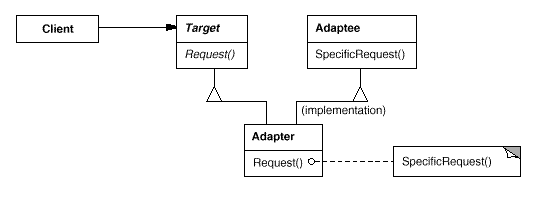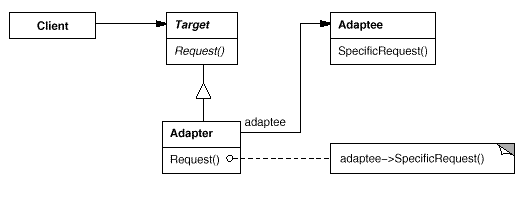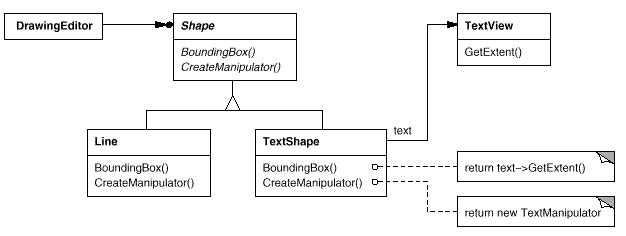Adapter
From CSSEMediaWiki
(Difference between revisions)
(New page: Adapter allows classes with incompatible interfaces work together, by converting the interface of one class into a form that a client expects. == Use when ==) |
|||
| Line 1: | Line 1: | ||
| − | Adapter allows classes with incompatible interfaces work together, by converting the interface of one class into a form that a client expects. | + | Adapter allows classes with incompatible interfaces work together, by converting the interface of one class into a form that a client expects. Basically you create an Adapter class as a go between to convert messages from one interface to another. |
| + | |||
| + | There are two kinds: | ||
| + | |||
| + | * Object adapter: makes use of a toolkit/library class to implement its functionality | ||
| + | * Class-based adapter: uses multiple inheritance to make use of another superclass's functionality | ||
== Use when == | == Use when == | ||
| + | * You have an existing class (eg toolkit or library), but its interface doesn't fit in with your system | ||
| + | * You want to create a reusable class that cooperates with unrelated or unforeseen classes | ||
| + | * Object adapter only: You need to use several existing subclasses, but you don't want to adapt their interface by subclassing each one. Object adapters can adapt the interface of the parent class. | ||
| + | |||
| + | == Structure == | ||
| + | |||
| + | From Gang of Four Design Patterns book: | ||
| + | |||
| + | Class based: | ||
| + | |||
| + | [[image: AdapterStructureClass.png]] | ||
| + | |||
| + | Object based: | ||
| + | |||
| + | [[image: AdapterStructureObject.png]] | ||
| + | |||
| + | ===Target=== | ||
| + | * Defines domain specific interface that a Client uses | ||
| + | |||
| + | ===Client=== | ||
| + | * Collaborates with objects that implement the Target interface | ||
| + | |||
| + | ===Adaptee=== | ||
| + | * An existing interface that needs adapting | ||
| + | |||
| + | ===Adapter=== | ||
| + | * Adapts the interface of Adaptee to the Target interface | ||
| + | |||
| + | Clients call operations on an Adapter object. The Adapter calls Adaptee operations to carry out the request. | ||
| + | |||
| + | == Example == | ||
| + | |||
| + | From the Gang of Four Design Patterns book: | ||
| + | |||
| + | [[image: AdapterExample.png]] | ||
Revision as of 00:26, 7 October 2008
Adapter allows classes with incompatible interfaces work together, by converting the interface of one class into a form that a client expects. Basically you create an Adapter class as a go between to convert messages from one interface to another.
There are two kinds:
- Object adapter: makes use of a toolkit/library class to implement its functionality
- Class-based adapter: uses multiple inheritance to make use of another superclass's functionality
Contents |
Use when
- You have an existing class (eg toolkit or library), but its interface doesn't fit in with your system
- You want to create a reusable class that cooperates with unrelated or unforeseen classes
- Object adapter only: You need to use several existing subclasses, but you don't want to adapt their interface by subclassing each one. Object adapters can adapt the interface of the parent class.
Structure
From Gang of Four Design Patterns book:
Class based:
Object based:
Target
- Defines domain specific interface that a Client uses
Client
- Collaborates with objects that implement the Target interface
Adaptee
- An existing interface that needs adapting
Adapter
- Adapts the interface of Adaptee to the Target interface
Clients call operations on an Adapter object. The Adapter calls Adaptee operations to carry out the request.
Example
From the Gang of Four Design Patterns book:


